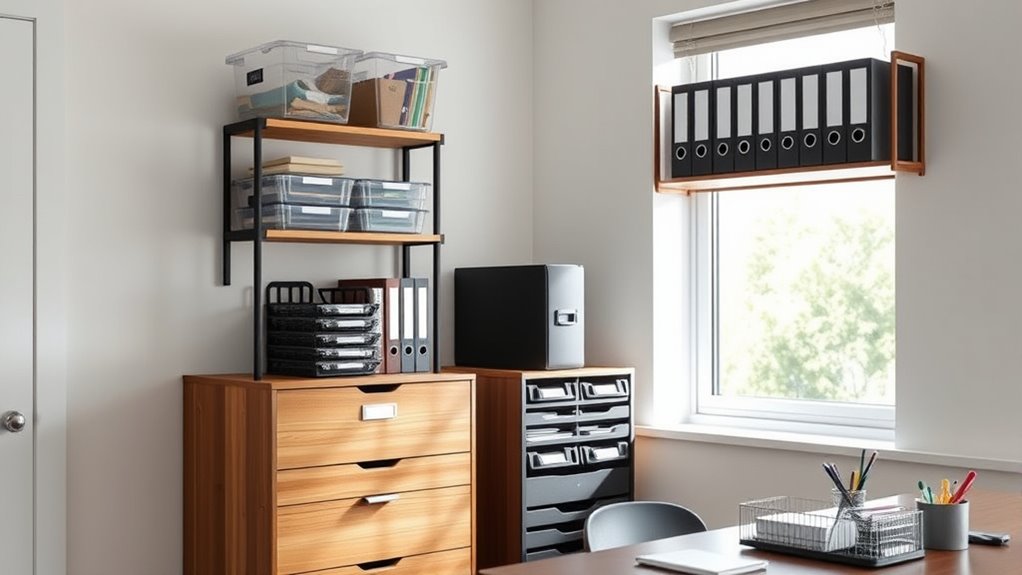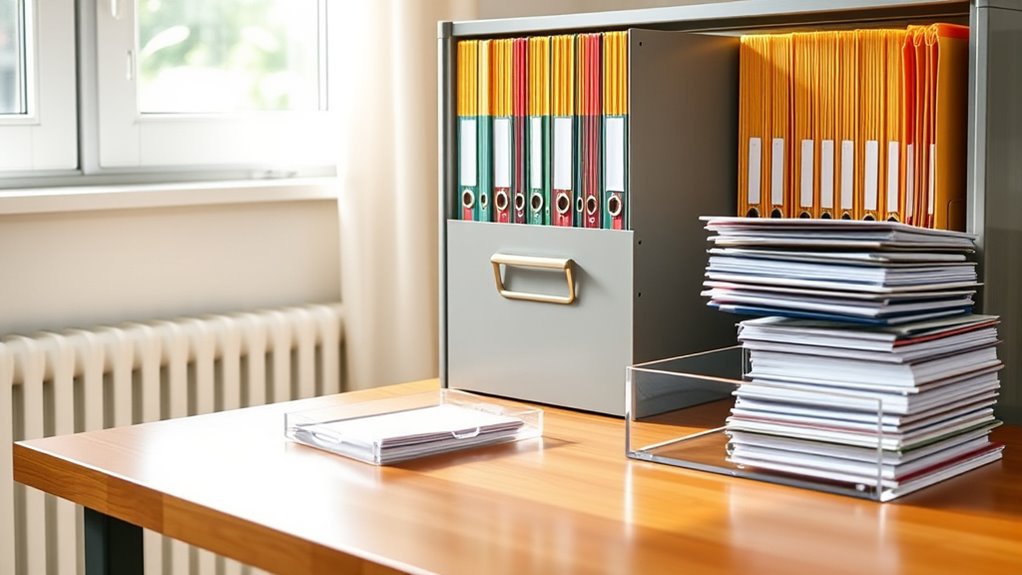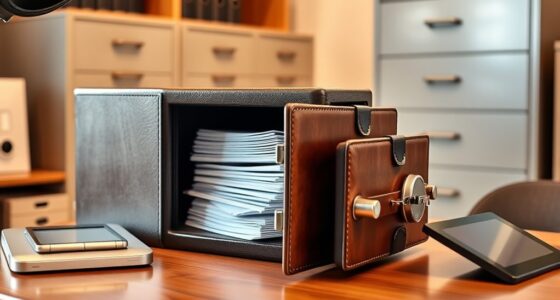To create a household document organization system, start by gathering all your papers and categorizing them into broad groups like insurance, medical, and financial. Use labeled folders, file boxes, or digital backups for quick access and security. Set a routine schedule to review and update files regularly, including digital backups with encryption. Ensuring privacy and security is key, so choose safe storage options. If you want a detailed plan to streamline your paperwork, keep exploring these helpful tips.
Key Takeaways
- Assess and categorize all household documents into broad groups like insurance, medical, legal, and home inventory.
- Choose durable storage options such as labeled folders, file boxes, or safes, and incorporate color coding for quick identification.
- Establish a routine to review, update, and declutter documents regularly, both physically and digitally.
- Digitize key documents by scanning and storing securely in organized, encrypted cloud folders with clear naming conventions.
- Implement strong security measures, including locked storage and encrypted digital backups, to protect sensitive information.
Assessing Your Current Document Collection

Before you can organize your household documents effectively, you need to understand what you currently have. Start by evaluating your current collection to identify document clutter and paper overload. Gather all papers in one place so you can see the full scope of what’s stored. Look for outdated bills, expired warranties, and unneeded notices. This step helps you recognize patterns of accumulation and areas where clutter builds up. Be honest about how much paper you’re holding onto and whether it’s necessary. Safety features in electronic devices like heated mattress pads highlight the importance of inspecting items for potential hazards. This process reveals your starting point, making it easier to develop a practical organization system. Clearing out unnecessary documents now prevents future paper overload and sets the foundation for a streamlined approach. Understanding your current collection is essential before moving forward.
Categorizing Your Household Documents

Once you’ve gathered your household documents, the next step is to categorize them into clear, logical groups. Start by reviewing your entire collection and creating broad document categories, such as insurance, medical, financial, and legal papers. Consider including a specific category for your home inventory, which lists your belongings and their values. Organizing documents into well-defined categories helps you locate important papers quickly and keeps everything manageable. Label each category clearly, perhaps with folders or labeled binders, so you can easily identify where each group belongs. This step streamlines your organization process and sets a solid foundation for secure storage later. Proper categorization guarantees your household documents are accessible when needed and reduces clutter. Additionally, understanding the importance of color accuracy can help you select better tools and methods for maintaining and retrieving these documents effectively.
Choosing the Right Storage Solutions

Selecting the right storage solutions is essential to keeping your household documents organized and protected. Start by choosing sturdy file folders to categorize and store papers neatly. Use labeled file folders for different categories like bills, medical records, and warranties. For larger or less frequently accessed documents, consider storage containers that are durable, water-resistant, and stackable. Clear containers make it easy to see contents at a glance, saving you time. If space is limited, vertical filing cabinets or file boxes can be effective. Guarantee all storage options are stored in a cool, dry place to prevent damage. Proper storage solutions not only keep your documents safe but also make retrieval quick and effortless when needed. Additionally, being aware of privacy and cookie usage can help you understand how your information is protected when managing your digital records.
Creating a System for Labeling and Filing

Creating a system for labeling and filing is essential to maintaining an organized household document setup. Start by choosing clear, consistent label designs that are easy to read. Incorporate color coding to quickly identify categories—use different colors for finances, medical records, warranties, and personal documents. Use a label maker or print labels with legible fonts to ensure clarity. Keep labels uniform in size and style for a tidy appearance. Place labels on folders, binders, or storage boxes consistently to facilitate quick retrieval. Avoid overcrowding labels; simplicity improves efficiency. Regularly review and update labels as needed to reflect changes. This approach streamlines your filing process, saves time, and keeps your household documents accessible and well-organized. Additionally, understanding file organization principles can help optimize your storage system for better efficiency.
Establishing a Regular Maintenance Routine

After organizing your household documents with clear labels and filing systems, the next step is to develop a routine for regular maintenance. Establishing consistent household routines helps you stay on top of document management and prevents clutter from building up. Create a document review schedule, such as monthly or quarterly, to check for outdated files, ensure important papers are current, and identify what needs to be added or discarded. Set reminders to follow this schedule so it becomes a habit. Regular maintenance keeps your filing system efficient and reliable, saving you time and stress when searching for essential documents. Incorporating document review schedules into your routine ensures ongoing organization and helps you quickly locate necessary papers when needed. By sticking to your routine, you maintain an organized, easy-to-navigate household document system that supports your daily life and long-term planning.
Digitizing Important Documents for Backup

To protect your important documents, start by scanning and saving digital copies of key files. Use cloud storage to keep them secure and easily accessible from anywhere. Organize your digital files so you can find what you need quickly and efficiently. Consider applying numerology principles to create personalized naming systems that help identify documents based on meaningful numbers or dates.
Scan and Save Files
Digitizing important documents is a crucial step in safeguarding your records against loss or damage. To do this effectively, scan each document and save the digital copies in clearly labeled folders. Use a consistent naming system and consider document indexing to make retrieval easier later. Once you’ve digitized the files, it’s wise to securely dispose of the paper copies. A paper shredder helps eliminate clutter and protects sensitive information from identity theft. Be sure to organize your digital files systematically, matching your folder structure to your paper filing system. Regularly back up these digital copies to an external drive or cloud storage. This way, you create a reliable backup, ensuring your important documents remain accessible and protected even if the original paper files are lost or damaged.
Use Cloud Storage
Using cloud storage for your digital documents offers a secure and convenient way to back up your files. It guarantees your important documents are safe from physical damage or loss. To maximize benefits, consider these steps:
- Choose a reputable cloud storage service that offers ample space and strong security features.
- Upload and organize your scanned files systematically for easy access and future reference.
- Use document sharing features to collaborate with family members or trusted contacts, ensuring everyone stays updated.
Cloud storage simplifies access from any device and makes sharing files quick and secure. It also provides an extra layer of backup, giving you peace of mind knowing your important household documents are protected and readily available whenever needed.
Organize Digital Files
Have you ever lost an important document because it was misplaced or damaged? Digitizing your key papers offers a reliable backup. Start by scanning important files and saving them in organized folders. Use clear, consistent file naming conventions so you can easily find what you need later. Upload these files to cloud storage for added security and access from any device. Regularly update your digital files to keep everything current. Consider creating separate folders for taxes, insurance, medical records, and warranties to stay organized. This system not only protects your documents but also saves space and reduces clutter. Additionally, implementing AI-driven security systems can provide an extra layer of protection for your digital files. By properly organizing digital files with thoughtful naming and cloud backup, you ensure your important documents are safe, accessible, and easy to retrieve whenever you need them.
Ensuring Security and Privacy of Sensitive Papers

You need to choose secure storage options like locked safes or fireproof cabinets to protect your sensitive papers. Implement restricted access measures, such as passwords or limited physical access, to guarantee prying eyes away. Additionally, use digital backup strategies like encrypted cloud storage to ensure your documents remain safe even if the originals are compromised. Maintaining transparency regarding affiliate relationships is also important when sharing information about your organizational system online.
Secure Storage Options
To protect sensitive papers from theft or unauthorized access, choosing the right storage options is essential. First, invest in a fireproof safe to safeguard crucial documents from fire damage and unauthorized retrieval. Second, consider installing lockable filing cabinets or safes in discreet locations to limit access. Third, use secure shredding services for documents that are no longer needed, ensuring sensitive information is destroyed securely. These steps help prevent identity theft and keep your private information protected. Additionally, regularly update and check your storage solutions to maintain security. Combining physical security measures with proper disposal practices keeps your household documents safe, private, and organized. Moreover, being aware of AI vulnerabilities can inform better security practices for digital information. Remember, a proactive approach is key to maintaining your documents’ security and privacy effectively.
Restricted Access Measures
Implementing restricted access measures is essential to maintaining the security and privacy of your sensitive papers. Start by using password protection on any physical or digital storage areas containing important documents. This adds a layer of security, ensuring only authorized individuals can open or view the contents. Consider using lockable filing cabinets or safes for highly sensitive items, and restrict access to these areas to trusted household members. Label storage locations clearly to prevent accidental exposure but avoid revealing sensitive information on labels. Regularly review who has access, and update passwords or security measures as needed. These steps help prevent unauthorized viewing, theft, or accidental disclosure, safeguarding your most confidential documents from potential threats.
Digital Backup Strategies
After securing your physical and digital storage areas, establishing robust digital backup strategies guarantees your sensitive documents remain protected even if the originals are lost, damaged, or stolen. To guarantee privacy and security, consider these steps:
- Use a reputable cloud backup service that offers automatic backups and version control.
- Apply strong encryption methods to your files before uploading, safeguarding your data from unauthorized access.
- Regularly update your passwords and enable two-factor authentication for added security.
Tips for Staying Organized Long-Term

Staying organized over the long term requires consistent effort and smart habits. Regularly review your household documents to guarantee everything stays current and accessible. Establish clear document retention policies, so important papers like insurance policies, tax records, and family emergency preparedness plans are kept for the appropriate time. Use labeled folders or digital folders to categorize documents logically, making it easier to find what you need quickly. Schedule routine check-ins to declutter and update your system. Keep emergency kits and critical documents in a designated, easily accessible spot. By making organization a regular habit, you prevent clutter from building up and ensure your family is prepared for any situation. Consistency is key to maintaining a reliable, stress-free system.
Frequently Asked Questions
How Often Should I Review and Update My Household Document System?
You should review and update your household document system at least once a year, or after major life events like moves or new family members. During these reviews, verify your digital backups are current and easily accessible in emergencies. Regular checks help you update contact info, insurance policies, and important documents, making sure your system remains reliable and accessible when you need it most.
What Are the Best Practices for Disposing of Old or Unnecessary Documents?
When disposing of old or unnecessary documents, you should prioritize secure shredding to protect your personal information. For digital files, delete them securely and consider creating digital backups of important documents before disposal. Always double-check that sensitive info is completely destroyed. This approach guarantees your information stays safe while decluttering your space efficiently. Regularly review your disposal practices to stay aligned with best security standards.
How Can I Involve Family Members in Maintaining Organization?
You can involve family members by encouraging family involvement and implementing delegation strategies. Assign specific roles, like one person managing bills or another handling warranties, to foster responsibility. Keep communication open, and make it a team effort so everyone feels invested. Regularly review the system together, offer positive feedback, and adjust tasks as needed. This approach makes maintaining organization manageable and guarantees everyone contributes to a well-organized household.
What Are Common Mistakes to Avoid When Organizing Household Documents?
You might think you’re safe, but avoid common mistakes when organizing household documents. Forgetting to regularly update your files can lead to missing essential papers when you need them most. Also, don’t misplace important papers in piles or drawers—this can cause chaos and stress. Stay vigilant, set a schedule for updates, and keep everything in clearly labeled folders. These steps will save you from surprises and keep your documents secure.
How Do I Handle Documents With Multiple Related Categories?
When handling documents with multiple related categories, use cross-referencing strategies to keep things clear. Digitally, link related files or tags for easy access, while paper documents can be organized with color-coded tabs or index references. Decide whether digital or paper organization suits each category best, and guarantee your system allows quick cross-referencing. This approach keeps your records connected and easily retrievable, preventing confusion and saving time.
Conclusion
Now that you’ve organized your household documents, you’ll be the envy of every cluttered closet. With a little effort, you’ll enjoy stress-free mornings and never lose an important paper again—except maybe that random receipt from 2012. Remember, a tidy system isn’t just about avoiding chaos; it’s about finally winning the battle against paper clutter. So go ahead, pat yourself on the back—just don’t forget where you put that elusive, perfectly labeled folder.








